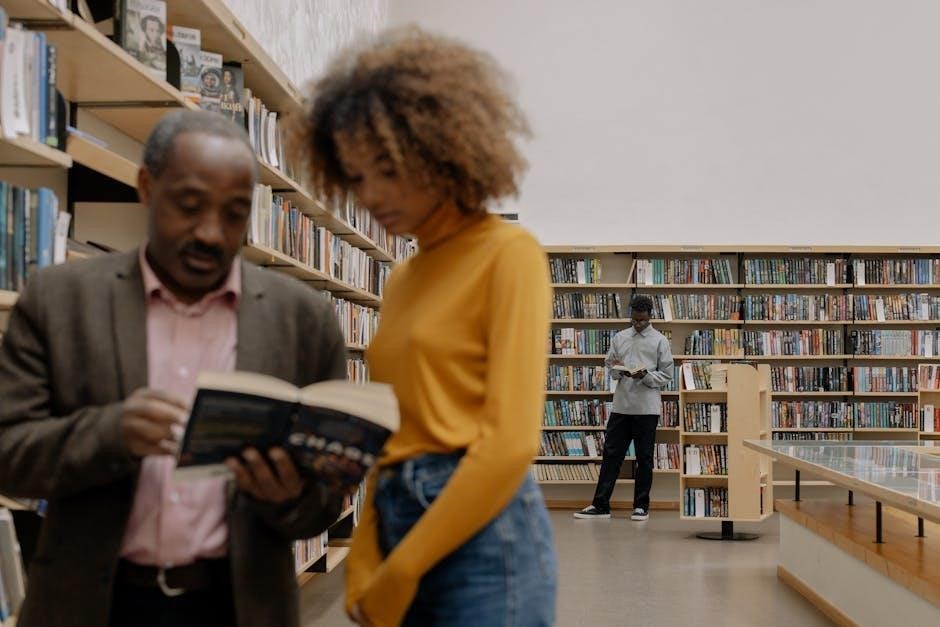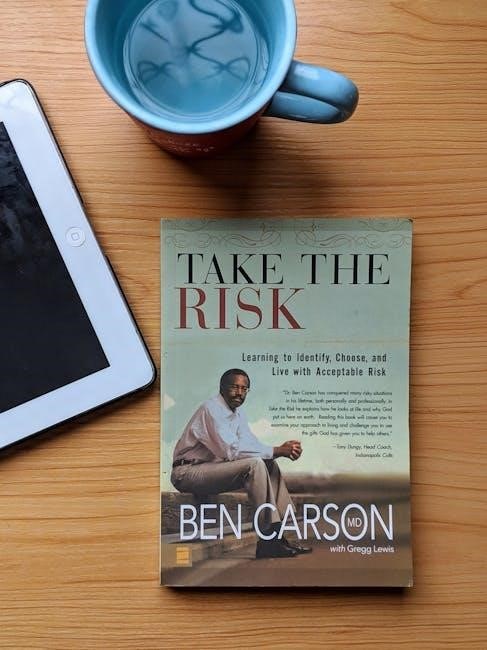In today’s information age, critical reading skills are essential to navigate the overwhelming amount of content. How to Read Nonfiction Like a Professor by Thomas C. Foster offers a guide to decoding nonfiction effectively, emphasizing understanding bias, questioning assumptions, and analyzing arguments. This approach helps readers become discerning thinkers in a world flooded with misinformation.
Understanding the Importance of Critical Reading in the Information Age
In today’s fast-paced, information-saturated world, critical reading is more crucial than ever. With the rise of fake news, biased reporting, and the 24/7 news cycle, discerning trustworthy sources has become a significant challenge. Critical reading empowers individuals to identify bias, question assumptions, and analyze arguments effectively. It fosters a deeper understanding of complex issues and helps readers avoid manipulation by misleading information. By cultivating these skills, readers can navigate the overwhelming amount of content with confidence, making informed decisions and engaging meaningfully with the world around them. This ability is not just a skill but a necessity in our increasingly complex and interconnected society.
Overview of Thomas C. Foster’s Approach to Nonfiction
Thomas C. Foster’s approach to reading nonfiction emphasizes critical thinking and analytical techniques. In his book, How to Read Nonfiction Like a Professor, Foster equips readers with tools to evaluate information critically. He focuses on identifying bias, questioning assumptions, and analyzing arguments. Foster’s method encourages readers to consider the context and perspective of the author, fostering a deeper understanding of the material. His approach is particularly relevant in today’s information age, where discerning trustworthy sources is increasingly challenging. By teaching readers to engage thoughtfully with nonfiction, Foster helps them navigate the complexities of modern media with confidence and discernment.

General Principles of Reading Nonfiction
Critical thinking is key to understanding nonfiction. Readers must evaluate sources, identify bias, question assumptions, and analyze evidence to form informed opinions and interpretations.
Identifying Bias and Perspective in Nonfiction Texts
Identifying bias and perspective is crucial when reading nonfiction. Authors often present information through their unique lens, shaped by experiences, beliefs, and cultural contexts. To uncover bias, readers must analyze the language, tone, and the perspectives presented or omitted. Questions like, “What is the author’s agenda?” or “Whose voices are missing?” help reveal underlying biases. Additionally, recognizing emotional appeals or selective use of facts can alert readers to potential manipulation. By staying vigilant to these elements, one can better understand the author’s intent and evaluate the credibility of the text more objectively.
Questioning Assumptions and Interrogating Claims
Questioning assumptions and interrogating claims are vital skills for engaging with nonfiction critically. Readers must actively challenge the premises and beliefs underlying an author’s arguments. This involves examining the evidence presented and evaluating its credibility. It’s essential to consider whether the author’s perspective is influenced by personal biases or cultural contexts that might skew their interpretation. Additionally, identifying logical fallacies and assessing the reliability of sources can help uncover potential manipulations. By doing so, readers can move beyond passive acceptance of information to a deeper understanding of the text’s intent and validity. This process fosters a more informed and discerning approach to reading.
Analyzing Arguments and Evidence
Analyzing arguments and evidence is a cornerstone of critical reading. Readers should identify the author’s central claims and evaluate the evidence presented to support them. This involves examining the logic, data, and expert opinions used to build the argument. It’s important to assess whether the evidence is relevant, sufficient, and credible. Additionally, recognizing logical fallacies or emotional appeals can help uncover weaknesses in the argument. Understanding the author’s perspective and potential biases is also crucial. By systematically breaking down the argument and evaluating its components, readers can determine the validity and persuasiveness of the text. This skill is essential for making informed decisions in today’s information-rich world.

Specific Reading Strategies for Different Genres
Foster provides tailored strategies for reading biographies, histories, science, and social media, emphasizing genre-specific approaches to deepen understanding and critical engagement with diverse nonfiction texts.
Reading Biographies: Understanding the Subject’s Context
Reading biographies requires placing the subject within their historical, cultural, and social contexts to fully grasp their motivations and actions. Foster emphasizes the importance of understanding how the subject’s environment shaped their decisions and perspectives. This involves analyzing the author’s portrayal of the subject’s background, relationships, and key events that defined their life. By examining these elements, readers can uncover underlying themes and patterns that reveal the subject’s true character. Additionally, considering the author’s own bias and perspective is crucial, as it influences how the subject is presented. This layered approach ensures a deeper, more nuanced understanding of the subject’s life and legacy.
Reading Histories: Separating Fact from Interpretation
Reading histories requires distinguishing between factual events and the author’s interpretation of those events. Foster highlights that historical narratives are often shaped by the author’s perspective, cultural context, and biases. To critically engage with historical texts, readers must question how the author selects and presents information, as well as the evidence used to support their claims. Understanding the historical context in which the text was written is equally important, as it influences the interpretation of events. By separating fact from interpretation, readers can form their own conclusions and evaluate the credibility of the narrative. This skill is essential for developing a nuanced understanding of history.

Reading Science and Technology Writing: Evaluating Expertise and Data
When engaging with science and technology writing, it’s crucial to evaluate the author’s expertise and the reliability of the data presented. Foster emphasizes the importance of identifying the author’s qualifications and potential biases, as these can influence the interpretation of scientific findings. Readers should also critically assess the sources of data, ensuring they are credible and up-to-date. Additionally, understanding the methodology behind the research and recognizing any gaps or limitations in the study can provide a clearer picture of the conclusions drawn. By scrutinizing expertise and data, readers can better discern the validity and relevance of scientific and technological information in nonfiction texts.

Reading Social Media: Navigating the 24/7 News Cycle
Navigating the relentless 24/7 news cycle on social media requires a discerning approach to sift through the noise. Foster advises readers to be vigilant about sources, recognizing that not all information is created equal. He suggests verifying claims through reputable outlets and cross-checking data to avoid falling for misinformation. Additionally, understanding the algorithms that prioritize content can help readers recognize how their feeds are curated, often reinforcing existing beliefs. By employing these strategies, individuals can critically engage with social media, distinguishing fact from opinion and fostering a more informed perspective in the digital age.

Critical Thinking Tools for Navigating Modern Media
Critical thinking tools empower readers to evaluate information objectively, recognizing misinformation and bias. Foster emphasizes understanding context, questioning assumptions, and evaluating sources to make informed decisions in today’s media landscape.
Recognizing Misinformation and Fake News

In a world saturated with information, distinguishing fact from fiction is crucial. How to Read Nonfiction Like a Professor highlights the importance of recognizing misinformation and fake news. Foster emphasizes the need to critically assess sources, identify biases, and question claims. The 24/7 news cycle and social media amplify falsehoods, making it essential to develop a keen eye for manipulation. Readers are encouraged to verify evidence, cross-reference information, and be wary of emotional appeals that obscure logic. By fostering these habits, individuals can navigate modern media with confidence, discerning truth from deception in an increasingly polarized world.
Understanding the Role of Context in Nonfiction
Context plays a pivotal role in interpreting nonfiction accurately. According to Thomas C. Foster, understanding the historical, cultural, and social backdrop of a text is essential to grasping its meaning. Without context, readers may misinterpret the author’s intent, especially in polarized or sensationalized content. Foster emphasizes that context shapes perspective, influencing how information is presented and perceived. By recognizing the broader context, readers can uncover underlying biases and motivations, enhancing their ability to critically evaluate nonfiction. This skill is particularly vital in today’s information landscape, where context often determines the validity and relevance of a narrative.
Evaluating Sources: Authority, Reliability, and Relevance
Evaluating sources is crucial for discerning credible information in nonfiction. Authority refers to the author’s expertise and qualifications, ensuring they are knowledgeable in their field. Reliability involves assessing the source’s trustworthiness, often through peer reviews or established publications. Relevance pertains to the source’s applicability and usefulness to the topic. By scrutinizing these aspects, readers can identify biases and ensure the information is both accurate and pertinent. This critical evaluation enhances understanding and helps in forming well-supported conclusions, aligning with Foster’s methodologies for effective nonfiction analysis.

Practical Strategies for Engaged Reading
Engaged reading involves active strategies like close reading, annotation, and questioning. These methods enhance comprehension and critical thinking, fostering a deeper connection with the text.
The Importance of Close Reading and Annotation
Close reading and annotation are vital strategies for engaging deeply with nonfiction texts. By carefully examining each sentence, readers uncover layers of meaning and identify key themes. Annotation involves marking up the text with notes, questions, and insights, fostering active engagement. This practice enhances comprehension, helping readers track arguments and evaluate evidence. It also encourages critical thinking, as readers challenge assumptions and explore alternative interpretations. Over time, these habits cultivate a more nuanced understanding of complex ideas. For nonfiction, where clarity and accuracy are paramount, close reading and annotation empower readers to discern fact from opinion and evaluate the author’s intent effectively.
Using Literary Techniques to Enhance Comprehension
Employing literary techniques enhances comprehension by revealing deeper meanings in nonfiction. Strategies like identifying metaphors, analyzing structure, and recognizing tone help readers uncover the author’s intent. For instance, metaphors can highlight underlying themes, while rhetorical questions engage the reader. Understanding these devices allows readers to evaluate arguments more effectively. Additionally, recognizing patterns in logic or emotional appeals aids in assessing credibility. By applying these techniques, readers gain a richer understanding of the text and develop a critical eye for persuasion and bias. This approach transforms reading into an active dialogue with the author, fostering deeper engagement and insight.
Developing a Personal System for Organizing and Reviewing Information
Creating a personal system for organizing and reviewing information is crucial for effective learning. Thomas C. Foster suggests using methods like note-taking, summarization, and categorization to structure knowledge. Digital tools or analog methods like journals can help track insights. Regular review sessions reinforce understanding and retention. This systematic approach ensures that readers can easily revisit complex concepts and integrate new information into their existing knowledge base. By developing a consistent method, readers enhance their ability to synthesize ideas and apply them in various contexts, making nonfiction reading more productive and meaningful over time.
Mastering these techniques empowers readers to critically engage with information, fostering deeper thinking and informed decision-making in today’s complex information age.
Applying Professor Foster’s Methods to Everyday Reading
By integrating Professor Foster’s techniques into daily reading routines, readers can enhance their ability to critically assess information. His methods, such as identifying biases and questioning assumptions, encourage a deeper engagement with texts. These strategies are particularly useful for navigating news articles, biographies, and social media, where misinformation often lurks. Foster’s approach fosters a mindset of skepticism and curiosity, enabling readers to discern credible sources and construct well-informed opinions. Regular practice of these methods not only improves comprehension but also equips individuals to handle the complexities of modern media effectively. Ultimately, applying these tools transforms reading into an active, enlightening process.

The Long-Term Benefits of Critical Reading Skills
Cultivating critical reading skills offers lasting benefits, enhancing both personal and professional growth. By mastering techniques like identifying biases and analyzing arguments, individuals develop a sharper understanding of complex texts. Over time, these skills foster intellectual independence, enabling readers to evaluate information objectively and make informed decisions. Critical reading also promotes lifelong learning, as it equips individuals to engage deeply with diverse perspectives and ideas. Ultimately, these abilities empower readers to navigate the ever-evolving media landscape with confidence, fostering a more thoughtful and discerning approach to information consumption.
